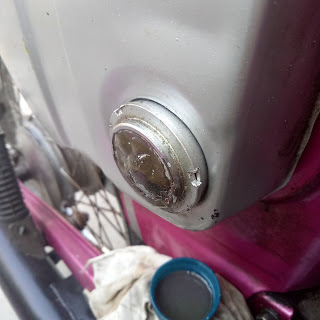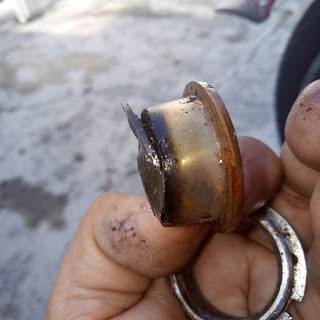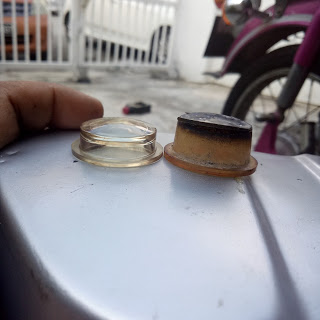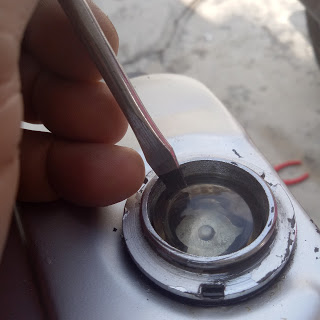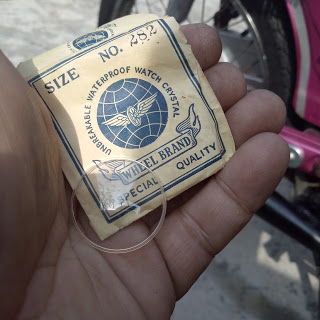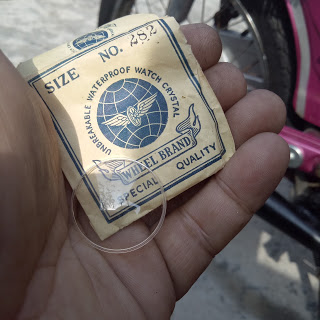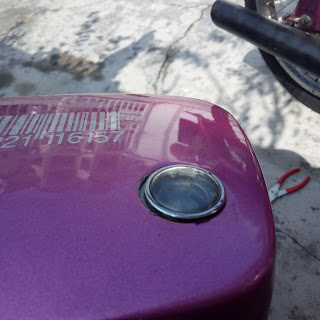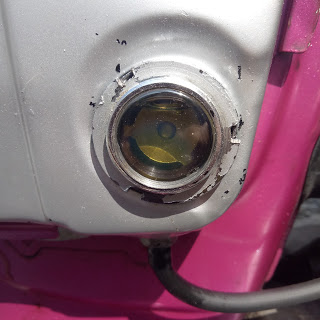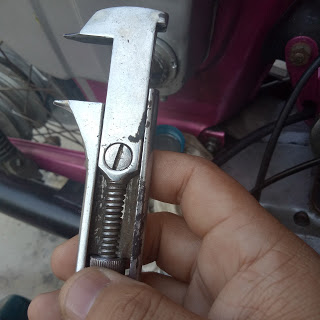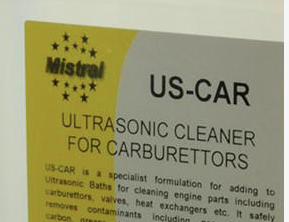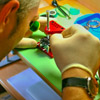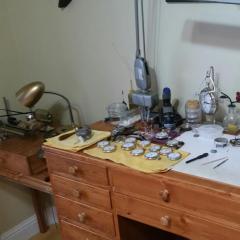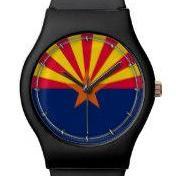Leaderboard
Popular Content
Showing content with the highest reputation on 03/01/18 in all areas
-
Well among my other interests, motorcycles probably rank as high as horology and recently I had occasion to use some horological knowledge on my bike. Problem was the sight glass for the 2-stroke oil was well knackered It looked like it had been subjected to heat at some point. I managed to source a replacement but the closest I could find was a similar diameter but with different height. and when installed it sat a few mm lower (in the pic below the window should sit flush with the surround). Well I measured the diameter and found it was 28mm. I pulled out a 282 crystal and inserted it using the claw. a few taps and its now flush. Here it is in place with the outer cover in position. Its not as clear as a correct original would be and your eyes need to be exactly level with the window when checking but it will do for an occasional bike which doesn't see much use. another aspect of watchmaking was this caseback opener which I attempted to use to remove the locking ring.. unsuccessfully. This was eventually removed by the trusty hammer and screwdriver. Anyone else used watch skills/tools on other hobbies? Anilv2 points
-
machining, model engineering, some electronics, writing articles on the craft, some photography (most for articles). Been at if for close to 30 years, I sure didn't know I end up this deeply into it (nor did the wife!) Things I've made: https://imgur.com/a/d2Y3a My garage shop: https://imgur.com/a/g8aKm My basement shop: https://imgur.com/a/BHIf1 added the M1, an Aciera F1 and another Schaublin 70 since taking those. Am now truly out of space.2 points
-
I need to figure out how to cross guitar world with watch world...wait! I did use a .09 guitar string for a click spring and it worked great, duration to the springiness on the steel. Ta Da Sent from my GT-N5110 using Tapatalk2 points
-
Well it is not a tool but a cleaning fluid. It is a concentrated ultrasonic cleaner (7:1 mix with warm water) for clocks but is also for cleaning carburettors. It is on order I will review when I have used it. Thinking about it, it is to remove old grease & oils etc so it should work & at £27.90 for 5 litres incl. delivery I thought it is was worth a punt. I purchased today from : https://mistralie.co.uk/products/ultrasonic-cleaner-for-clocks2 points
-
I debated whether to post this, it’s verbose and sounds like a lecture. But I see the subject wrestled with all the time and thought a summary from someone who has done lots of it might help you - and the next guy. Here’s imo pretty much all you need to know to get some successful results from DIY heat treating: 1) Drill rod IS tool steel IS Silver steel. The name silver steel is the common name in the UK, drill rod in North America. Also called carbon tool steel. 2) you HAVE to know what tool steel the drill rod is: O1 (oil hardening) or W1 (water hardening). Don't buy drill rod without knowing what it is. Another common tool steel is A2 (air hardening). It’s more expensive so less likely to what he drill rod is at the local outlet 3) Why do you have to know? The quench is different - oil for O1, water for W1, air for A2 4) Why the different quenches? Different fluids (Water, air, oil, ice cold brine) have different quench speeds suitable for different tool steel alloys 5) What happens if I quench O1 in water, and vice versa? Water is too fast a quench for O1, you risk cracking it. Oil is too slow for W1, it won't harden as much as it could/should. 6) Which tools steel is best? W1 is the cheapest. Most imo prefer O1, it machines well and is less likely to distort or crack in the quench than W1 7) What oil to use? Doesn't much matter. I use a mineral oil I keep after draining a machine tool’s gearbox. For the size of parts watchmakers deal with, just get a quart of hydraulic oil from the hardware/auto store (Canadian Tire for us canucks). Hydraulic oil is just very pure mineral oil without all detergent and additives in motor oil (which you could also use, used or new). Use a tin can, not a glass jar or plastic container. Ideally the oil should be warmed on a hotplate (slower quench for O1), but I confess I don’t usually bother without ill results (cracking) 8) is the quench dangerous? no, for the size of stuff we’re doing. It takes a lot of heat to ignite oil. You'll get a small plume of smoke that smells and that's about it. There are special quench oils with a high flash point available; they make less smoke; I’ve never bothered 9) Where to get O1? Any industrial supply place. In Canada, metal supermarkets, Fastenal, Granger, Brafasco, KBC - heck even some hardware stores. Catalogue houses, KBC, McMaster Carr, MSC and so on. It’s so common it should be like picking up milk on the way home lol. I would avoid ebay and offshore mail order, while metallurgy and controls have only gotten better, the same hasn't necessarily happened to QC in the developing world. I think the last time I bought small dia O1, its was $3 or $4 for a 3' piece of 1/8" O1 from KBC. imo its not worth going to a less than mainstream source....the mainstream vendors mostly sell to industry and that's your QC, business and toolmakers won't put up with crappy tool steel. 10) What is heat treatment? If the steel has enough carbon (is a tool steel), you can change its state by heat treating. This is usually done to harden the material. Three words to know: Hardened, Annealed and Tempered 11) Hardened. The steel has been brought up to its critical temp (1500F or bright red in sunlight) held for a bit then quenched. When above the critical temp, the molecules arrange themselves in a structure (austenite) that gets "locked in" when its quenched. After a proper quench the steel is as hard as it can get, and also brittle. 12) Tempering. After hardening, the steel temp is raised again, slightly, to let it down or remove some of the brittleness at the expense of hardness. How much its let down is (mostly) a function of temp and it so happens these temps correspond well to some colours. light straw through blue etc. You temper to a higher temp, say blue, around 600F, for something like a screwdriver - you want it somewhat hard, but not brittle. A cutting tool you'd temper less. When tempering you can quench to stop the tempering or heat flowing, but it’s not necessary for the tempering to work Polish a bit of the hardened steel so you can see the tempering colours, heat slowly, they change rapidly 13) Annealing or annealed steel. Steel in its soft state, unhardened. Except for special examples like watchmakers blued steel (which will be O1 or W1) tool steel is sold annealed so it’s ready to be machined into whatever 14) how is annealing done? Kind of the opposite a rapid cool (quench). Heat to critical temp and then slowly cool. Slowly as in overnight (a steel box full of ashes works well – use extra thermal mass if the part is small). With a proper anneal the stress in the metal will be removed and it will be soft. You'll hear of guys talking about annealing in much short time frame; what’s really happening is it’s a partial anneal - they've softened it enough for what they need. Residual stress may remain which could lead to cracking on subsequent quenches (if necessary) 15) Casehardening. By soaking a non tool steel in an environment (a bath or packed with carbon around it in a steel box) where it can absorb carbon for a period of time, you can get it such that the out layer has enough carbon to then be heat treatable. It’s then quenched. It is not usually (ever?) tempered. The idea is it’s an advantage having a dead hard skin and ductile core. The skin depth might be 1 -2 thou using casehardening compound, 5-10 thou with long pack hardening and 50 thou with an overnight soak at a commercial heat treaters. It’s good for wear parts, not so good for most tools 16) HSS – high speed steel. High speed steel is another group of tool steels we see, drills, lathe tools etc. Its great advantage is it holds its hardness at high temps, unlike say O1 that starts to anneal at a few hundred degrees. This matters as where one molecule meets another when cutting, temps can go very high. HSS cannot be heat treated by the likes of us, there is a very narrow band of tolerance on the temperatures and cycles required2 points
-
Oops, I did it again. I'm really trying to stop buying watches for a bit, but stumbled on what I thought was a very cool-looking watch from the late sixties/early seventies. I dug the "atomic transistor" logo, and it looked super clean. Being that it was in a monocoque case, and that I bought a crystal vise to deal with them, I decided to take the gamble. It just looked really clean. The insides were just as clean as the outside, and the battery checked out to 0 volts, so I knew one thing. Since this ESA Dynatron movement takes a rather odd battery, 344/1136, I had to wait to get one delivered. It came today and I put it in the watch. At first it wouldn't get going. Then I remembered that it has a hacking mechanism and the stem was in winding position. I popped into "wind" position and gave her a little twist and off she went. It seems to run pretty well but if the stem is pulled out and the watch stopped, it takes a twist to get it running again. I don't know if it's designed that way or the watch is somehow out of electronic beat? Anyway, I'm stoked on the watch. It's very cool to watch the hybrid mechanism that has a balance wheel that is impulsed electronically. I hope the video I took with my phone shows up. If not, you can take my word that it's running. IMG_0855.MOV1 point
-
I'll copy transfer the points with my "dial feet position gauge" to a sheet of paper and measure the distances and angles. Then I 3D print simple dial holder which I use to transfer the correct positions.1 point
-
Watch tools on other things? Na, Other tools on watches, yup! Hammer and Screwdriver on the %^&*( case back and then hammer on the watch! It opened :-)1 point
-
I think I've got the "bench practices for watch and clock makers", as least from googling what the cover looks like....however the TOC you've shown sounds similar what I have. I wonder if there is lots of overlap? Tonight when I get home I could scan the TOC so as to compare. The man close to unrivaled in knowledge and ability, a good writer and teacher and amazing illustrator.....so its I'd think of owning any of his works a win1 point
-
I have used my ultrasonic carb cleaner at the shop to clean stubborn stainless cases, but I didn't want to tell anybody As long as its good stainless it doesnt hurt anything. Carb cleaner is pretty strong stuff. Have also used CLR in my jewelry ultrasonic for stubborn rust on stainless cases. Be careful though...1 point
-
Years ago I switched to restoring and repairing clocks (there is a difference) In the past I have restored some wonderful time keepers. Making the parts was a challenge but such fun. Working on complicated mechanisms many with month duration. There is always something new, you never learn everything.1 point
-
Clocks are larger in size so in theory easier to work on. However clocks require unique tools such as a good spring winder, a stand to hold the movement whilst testing and regulating. Re - bushing is also a common task required with the vintage clocks which does take a bit of practice to achieve success. Also getting a Westminster clock to work & chime correctly can sometimes be a real challenge. So you are correct clocks require different technics for sure but as with watches the work can be very rewarding.1 point
-
That is going to be very difficult to source. You will have to make one. Perhaps convert one of these gems you have the template. https://www.ebay.co.uk/itm/GOOD-LOT-OF-POCKET-WATCH-CLICK-AND-RETURN-PIECES-FOR-THE-WATCHMAKER/382394137667?hash=item5908777c43:g:bwUAAOSwKH5alYzI1 point
-
Thanks. I've tried doing that methodically, and the Jacobs chuck fits solidly, but is not completely true depending on what angle it enters the collet. I think I may turn a straight arbor for the chuck and then mount in the largest collet I can find, eg. a 6mm collet, as I reckon this would turn truer.1 point
-
Mine says hello! Love how "tall" the hour markers are. Sent from my E6790TM using Tapatalk1 point
-
From what I have read each maker used their own "standard", I measured mine when I got it (a Boley clone), it measured 4mm to 3mm over a 17mm length. Doing the math on a cad program it gave me something like 1.7 degrees included angle. The way you are doing it is about the only way to get it to fit your particular lathe. There's a video somewhere on YouTube where the guy is doing exactly how you are for the same purpose.1 point
-
During my TZ courses, I had to purchase selected tools for each stage of the course, from there I went on, and purchased many more as time went by, tools, and equipment in watchmaking is a never ending procedure, but it doesn't have to be a burden, it can be a good investment, that said, save your money and buy wisely.1 point
-
An easy test to see if it has enough carbon in it to harden is the 'spark test. Its not fool proof but it will definitely let you know if its not carbon steel. If you have a grinder just grind a bit of it and watch the sparks, carbon steel will have sparks explode off the sparks like little fireworks, mild still will have just straight sparks, look here for a better explanation https://en.wikipedia.org/wiki/Spark_testing.1 point
-
My wife bought me this Official Cosmonauts for me for our wedding 15 years ago. It was my Grail watch before I knew the term. The stem broke awhile ago. Eventually I decided to take it to Right Time in Denver. Fortis finally shipped the parts after a couple months and got it back yesterday. Oh how I've missed it! I am really digging it on this new black nato with matching satin stainless steel hardware (originally got this strap for my Lunar Pilot).1 point



